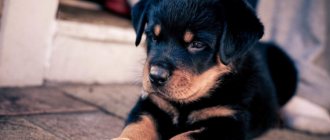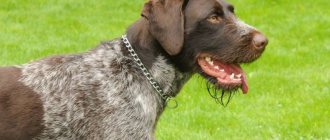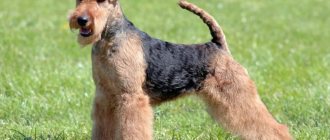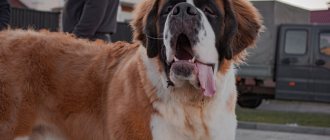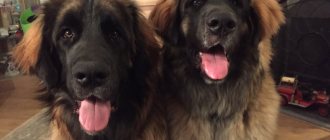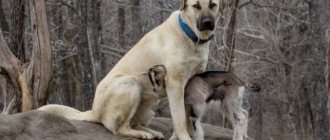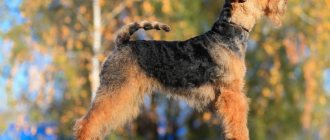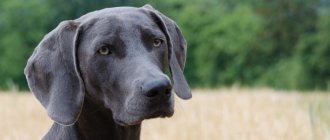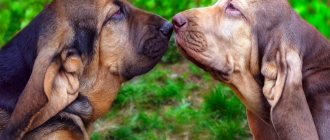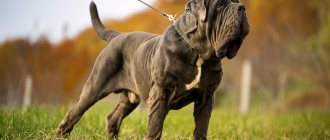An elegant aristocrat - there is no other way to call this sophisticated creature with an intelligent look and long paws. But the Greyhound is valued all over the world not only for its striking appearance and remarkable intelligence. He is recognized as the best runner, as he can run up to 67 kilometers per hour. This quality, plus the excellent skills of a born hunter, together make this breed one of the best hunting hounds.
Description of the Greyhound breed
Popularity 206th place among 263 dog breeds
Lifespan:
9-11 years
Breed group:
Greyhounds
Height:
males: 71-77 cm, females: 68-71 cm
Country of origin:
Great Britain
Average price:
25-35 thousand rubles
Weight:
males: 29-32 kg, females: 27-29 kg
Latest articles Cat health
Ataxia in cats: what is it, how does it manifest and is treated 01/23/2022 187 0 0
Cat health
Leukemia, or viral leukemia in cats 01/23/2022 162 0 0
Key facts
Greyhounds are among the fastest dogs in existence today. They are designed for running or hunting field game.
Another name for the four-legged dog is associated with its country of origin - the English greyhound. When literally translated, the name of the breed sounds like a gray greyhound, or a cricket greyhound (griehound).
The description of greyhounds is unusual: despite their passion for hunting and love of running, they are considered large sleepyheads. Dogs can fall asleep instantly, and not even in the most convenient places for this. Dogs show incredible love for their owner and become loyal friends and excellent companions. They know how to show understanding and delicacy in various situations.
In terms of mental indicators and intelligence, greyhounds took 46th place of honor in the list of the most intelligent breeds according to Stanley Coren. The characteristics of the Greyhound breed are always based on these indicators, first of all.
In English greyhounds, conscious age occurs only at 1.5-2 years. Until this time, they show childish spontaneity and are ready to play pranks and play without interruption.
Representatives of the English breed cannot be classified as long-livers. The average lifespan of a Greyhound is only 9-11 years. The weight of the female varies from 27 kg to 29 kg, the male – in the range of 29-32 kg. The height at the withers in females reaches 68-71 cm, in males the height is slightly higher - 71-77 cm.
Characteristics of the English Greyhound dog
| Attachment level | High |
| Friendliness | High |
| Child Friendly | High |
| Loyalty to other pets | High |
| Exercise needs | High |
| Playfulness | High |
| Energy level | Average |
| Learning ability | Average |
| Intelligence | High |
| Tendency to bark | Low |
| Shedding amount | Average |
History of the origin of the Greyhound
There are no precisely confirmed historical facts about the past of the gray greyhound. At first, Ancient Egypt was called their homeland, where drawings of similar dogs and their mummified remains were found. But a 2004 genetic study refuted this view. During the analyses, it was found that they have no relationship with Egyptian individuals. It turned out that greyhounds have a lot in common with shepherd dogs. This discovery prompted scientists to think about the ancient Celtic origin of the breed.
In the first half of the 10th century, the so-called Egyptian dogs began to spread in European countries. In Foggy Albion they were used for hunting without a gun. Excellent short-distance runners were able to easily catch a hare or a roe deer. This type of entertainment was preferred by the European nobility, so these swift dogs became the favorites of noble people.
Closer to the 18th century, there was a decline in the popularity of the breed. But the work of the British greyhound breeder Lord Alford bore fruit. He sought to improve the breed, so he diluted the greyhound blood with the blood of the English bulldog. With this Alford wanted to achieve greater endurance in the dogs. In 1776, the first hunting club appeared in England, in which tests of the working qualities of the gray greyhound were carried out.
At the end of the 19th century, interest in greyhound racing grew, in which greyhounds found it difficult to compete. At the same time, three branches of animals were identified: exhibition, racing and hunting. Official world recognition of the breed took place in 1946 after the opening of the first greyhound fan club in Great Britain.
Interesting fact: in 1994, a representative of the English breed named Star Title was noted as the fastest dog in the world in the Guinness Book of Records. His speed at the competition was 67.32 km/h.
The high cost and belonging to elite pets has long prevented dogs from gaining popularity not only in the country of origin, but also beyond its borders. In Russia, individuals of this breed became widespread only after the collapse of the USSR - until that time they were considered a relic of capitalism. Now there are a number of kennels engaged in breeding and popularizing gray greyhounds, but their numbers in our country remain small.
What do greyhounds get sick of?
Below are some greyhound diseases you should be aware of:
- Gastric dilatation - Volvulus : Tendency to produce gas and bloating, which can lead to gastric torsion and a medical emergency.
— Hip dysplasia : an inherited disease that causes lameness and arthritis.
— Osteosarcoma : An aggressive bone cancer, and one of its first signs is limping. It can be treated with amputation and chemotherapy.
— Hypothyroidism is a disease of the thyroid gland that can be treated with medication.
- Sensitivity to anesthesia: Greyhounds require less anesthesia than other dogs of the same size, and a regular dose can be fatal. They metabolize barbiturates slowly.
- Insecticide Sensitivity: Greyhounds are sensitive to pyrethrin-based collars and sprays and need to use alternative products.
Greyhound appearance
General impression
Breeding of the breed is carried out along three lines:
- the show class is represented by beautiful individuals with a height at the withers of at least 77 cm, intended for participation in exhibitions and shows;
- racing dogs, which are athletes from birth and have strong muscles;
- hunters for whom performance is valued more than appearance.
It is not recommended to mix animals of different branches, so as not to lose their innate qualities.
In general, greyhounds combine natural stature, an elegant figure and necessarily long legs. The photo of a greyhound clearly shows how the muscles are stretched along the body, so the silhouette looks sophisticated.
Head
The dog's moderately long and wide head has a flat skull. An elongated, lean muzzle should look textured. The English Greyhound's jaws form massive scissors when connected, with the upper incisors covering the outside of the lower teeth.
The slightly slanted eyes of the Greyhound are oval in shape. In a healthy pet they are dark in color and shiny. With light colors, a not too dark shade of the iris is possible. The ears are thin, neat, protrude back, but rise when alert.
Neck
Like the rest of the Gray Greyhound's body, it should be muscular and elongated, with an elegant transition to the withers. There are no skin folds, wrinkles or dewlap on the neck.
Torso
It looks quite stretched due to the longitudinal muscles and is very powerful, but not stocky. The dog's chest is deep, with a relief transition to the stomach and convex ribs. The back has a massive lower back and muscles of increased density.
Forelegs
The front legs of the individual are distinguished by well-developed muscles and dry outlines. The shoulder blades are inclined, the elbows are freely located under them. The pasterns are round in shape with tight pads.
Hind limbs
Designed for powerful pushing, the hind legs have strong shins and thighs. The wide hock joints are set fairly low. The knees are clearly visible. Pets have strongly arched fingers and dense nails that require regular care.
Tail
The Greyhound's tail is thick at the base and tapers towards the tip. It is low-slung and is considered a rudder when the dog is moving. A slight bend starts from the middle in any position of the animal.
Movement
The English greyhound moves with sweeping movements. This allows her to accelerate quickly. The tremors are quite strong, but still inferior to some other trotting breeds.
Wool
The coat fits tightly to the animal's body. The hair is smooth to the touch, with a dense structure. There is little undercoat on the entire body. The coat is less dense on the belly and inner thighs.
Color
There are individuals of different colors: red, black, white, brindle and fawn. Sometimes the colors are diluted with white spots. This is not prohibited by the breed standard.
Size
The size of the greyhound, despite its grace, is impressive. These are quite tall dogs, for example, the height of a male greyhound reaches 77 cm, and that of a female - 71 cm. The weight of greyhounds depends on gender: in females it reaches 27-29 kg, males weigh a little more - 29-32 kg.
Breed standard
As mentioned before, greyhounds are very similar to Italian Greyhounds, which is easy to see in the photo. However, they should not be classified as the same breed. Indeed, despite the enormous similarity (which is why even Italian Greyhounds received the second name “ Italian Greyhounds ”), these two types of dogs have their own distinctive features.
A group of greyhounds on a walk in summer
So what are the breed standards? Greyhounds are characterized by a strong build and even muscularity, an elongated head, a long neck, a convex loin and, as befits a racing dog, strong legs. On average, an adult dog of this breed weighs approximately 26 to 40 kilograms. The approximate height of the female is 70 centimeters, the male is slightly larger - 74.
Thoroughbred Greyhounds will have a subtle transition between the forehead and muzzle, with particularly well-developed powerful jaws with strong white teeth. They typically have dark eyes and small, petal-shaped ears with short hair.
The paws of this breed are of medium length, on which it is easy to find dense pads all for the same comfort when running. Another feature of the breed is its long tail, which tapers towards the end. Usually dogs keep it slightly curved, trying not to raise it too far from the ground.
As for the coat, there is only one general rule: it is short, thin and close-lying. There are no strict restrictions in terms of color. Black, red, white, brown, brindle or any other color in combination with white. You can find a Greyhound to suit every taste.
Greyhound character
Representatives of the English breed combine the characteristics of a tireless athlete and an imposing couch potato. At home, a dog can spend the whole day half asleep on a rug or in a bed. But once prey appears on the horizon, the greyhound will be unstoppable.
Dogs are herd animals and are very dependent on the group. They consider the owner's family and other gray greyhounds living in the neighborhood to be a pack. However, there should be only one leader: the rest are obliged to obey him. If the pet lives with people, then the owner of the dog becomes the leader. If living with other greyhounds, the leader is chosen through psychological pressure and even fights.
Greyhounds treat children calmly, without irritation, but will not take part in games. But they have boundless love for their adult owner. Licking his face and throwing himself on his neck when he meets him is the dog’s household duty.
Greyhounds are able to live peacefully with other animals, but if they treat a domestic cat calmly, then the yard cat will become an object of hunting. Four-legged dogs can also confuse decorative dogs with game, so when walking on the street you should use a leash so as not to lose your pet or get into trouble.
Greyhounds have low guarding qualities, so they are not used as watchdogs. They treat strangers favorably and are ready to endure their stroking and attention in order to please the owner. In general, the Greyhound's character can be called more friendly than withdrawn.
Character and behavioral characteristics
The Greyhound is distinguished by specific temperamental traits that can please not only an experienced hunter, but also any ordinary lover of this dog breed:
Intelligence. Very smart and sensitive to a person's mood and voice. Grasping everything on the fly, the gray learns quickly and, over time, seems to predict the desires of its owner.
Vulnerability. Because of their empathy, greyhounds are extremely vulnerable and sensitive. They are one of those breeds that you absolutely cannot shout at or raise your hand at, otherwise the dog withdraws into itself and stops responding to its owner.
High quality vision. Most hunting dogs use scent only. Vision is the main advantage of greyhounds, allowing them to detect and instantly react to small prey.
Calm disposition. Many greyhounds suffer from mood swings. The Greyhound is an exception. We can say that he has a phlegmatic temperament.
Getting used to it. Quickly adapts to the daily routine, easily tolerates changes of environment and loneliness.
Friendliness. They are very sociable with both people and representatives of the animal world. They love to play, but sensing the owner’s mood they will never force themselves on them at inappropriate times for play.
Education and training
English greyhounds are considered to be animals that are very difficult to train. Indeed, it is quite difficult to accustom them to commands due to their habit of being independent during hunting. Greyhounds are very artistic and love to show it off in the ring.
Education and training begin upon reaching adulthood. There is no point in training puppies, because at this time they are practically uncontrollable, and nothing can be done about it. You will have to be patient and wait for the pet to grow up.
Experienced dog trainers advise starting training no earlier than 1 year. But by this age the baby must:
- understand the owner’s prohibitions;
- respond to the nickname the first time;
- be able to walk on a leash.
English greyhounds are happy to train if they feel excitement and interest in what is happening. When they are bored, they will not do anything. Food is also not a basis for them to fulfill the commands and demands of the owner. Greyhounds should be encouraged by showing attention and wanting to spend time with him.
Due to the nature of the fidget, it is difficult to carry out commands that require waiting. They always want to run somewhere and play pranks. However, the commands “Sit!”, “Wait!” a trained animal must be one of the first to master.
Puppies of the sporting branch begin to be trained at 2-3 months. They are chased after a toy, then taught to run distances of no more than 100 meters after the bait. Gradually the distance increases. You can train your pet by tying it to a bicycle using a special leash. Overload, especially at a young age, can have a bad effect on your health and even lead to heart problems.
Honing hunting skills begins with accustoming to smells. To do this, 2-3 month old babies are brought to the field and allowed to walk around on a leash, sniffing at what surrounds them. At six months the animal is trained to bring prey using a special toy.
It is important for exhibition animals to have the correct exterior. You will have to carefully care for the dog’s appearance and teach it to walk in the ring. To begin with, use a muzzle, gradually you need to abandon it.
Looking for a Greyhound? Find your pet from 1 offer As a gift
Hare hunting
Greyhounds begin to prepare for hunting at three months of age. At this time, the puppy is just getting acquainted with the prey. For this purpose, a live hare is tied up and shown to the puppy. It is important to stay close to your pet, since a hare is a wild animal that can bite a baby, leaving him with psychological trauma in the form of fear of hunting. To awaken the dog's hunting instinct, it is necessary to hold the hare in front of the puppy. After the baby grabs the prey, praise and repeat. It is advisable to train several puppies at once to develop the spirit of competition.
The next stage begins at the age of six months. A teenager is taken hunting with other dogs. At this stage, the dog gets used to the car and watches the adults hunt.
At eight months of age, the greyhound should periodically receive baited prey to play with in order to get used to holding it in its teeth. At this time, it is important to teach how to give up the prey; to do this, after she has patted the hare a little, you need to lightly hit her on the head and then reward her. It is strictly not recommended to give the entrails or meat of the prey to eat, otherwise the pet will kill and tear the hare on the spot or, on the contrary, run away from the owner with it.
Greyhounds are fed five hours before hunting, otherwise they will be clumsy. In addition, a well-fed dog running at high speed runs the risk of intestinal volvulus. If the hunt goes on for a long time, it is necessary to water the dog; you can feed it only upon return.
Greyhound Health and Disease
Possible diseases
Greyhounds are not prone to frequent illness and rarely have genetic problems. Due to physiological characteristics, the animal needs soft and warm bedding, as it is afraid of drafts. Because of this, frequent colds are possible.
Osteosarcoma is considered the most dangerous disease in dogs. This is a bone cancer that often cannot be cured. The first symptom is the pet's lameness.
Eye diseases of greyhounds, in addition to inflammation and conjunctivitis, include pannus. This is a hereditary disease that appears between the ages of 2 and 5 years. It is characterized by clouding of the lens of the eye. There is only symptomatic treatment; it is impossible to completely get rid of the problem. When left untreated, pannus leads to blindness.
Thyroid gland dysfunction leads to hypothyroidism. Its result is infertility, slowness, and deterioration of the animal's coat.
Typical diseases of greyhounds include:
· age-related joint problems;
· deafness;
· skin and food allergies;
· pneumonia.
If you discover problems in your pet's health, you should immediately contact a veterinarian. Regular antiparasitic treatments for your pet should not be neglected. Routine vaccination against rabies, distemper, enteritis, viral hepatitis, and leptospirosis will help maintain a quality life.
The first vaccinations are given at 2 months, and after 3 weeks they are repeated. At six months they give an injection against rabies and carry out a third comprehensive vaccination. From the age of one year and annually they are vaccinated against a set of viral diseases.
Reproductive health
Female English greyhounds become sexually mature at 1.5-2 years of age. The body of a dog of this age is ready for mating and the birth of healthy offspring. Usually mating occurs 10-15 days after the start of estrus. Bitches can be spayed after their third estrus.
It is better to carry out mating in the male dog’s territory. It is important to be patient because dogs are quite shy and take time to get used to.
Possible diseases
Greyhounds are completely free from hereditary diseases, but there are a number of diseases that can harm your pet's health. First of all, due to their active lifestyle, these dogs are susceptible to diseases of the joints and muscles, especially rheumatism and arthritis.
Greyhound mother with offspring
For the same reason, you should pay attention to the dog's gait. If even the slightest hint of lameness appears, you should immediately contact a specialist, since your pet may well have bone cancer.
Another problem is the high probability of an allergic reaction to medications, therefore, before each use of the medicine, you must consult a veterinarian.
In general, Greyhound dogs are distinguished by good health. It is very rare that they develop serious illnesses common to other breeds. Average life expectancy is 14 years.
Greyhounds are active dogs
Features of feeding and diet
Despite their apparent thinness, Greyhounds love to eat and will not be capricious when choosing tasty morsels. The dog will happily accept any food from the owner's hands. However, the diet should be high in calories; the diet should be based on lean meat. Offal and low-bone fish make good additions. Care must be taken with wild-caught game. Giving your dog wild meat is only possible after veterinary control, otherwise dangerous parasites can harm the pet’s health.
Up to 6 months, the puppy needs to be fed at least 5-6 times a day. Food should be rich in healthy vitamins and minerals. The basis of the diet is low-calorie fermented milk products, low-fat cottage cheese, boiled chicken egg yolk mixed with dairy products. After one month of age, it is useful to give cartilage and non-tubular bones to strengthen the baby’s teeth and jaw.
The proportion of porridge should not exceed a quarter of the adult dog’s feeding norm. Rolled oats, buckwheat and rice cereals are recommended. It is useful to add raw, grated vegetables and fruits to food. Consuming fish oil or vegetable oils for your pet will have a good effect on the appearance of the coat.
The owner decides what to feed the greyhound, but some breeders prefer to combine natural and dry food. By doing this, they solve the problem of enriching the diet with vitamin and mineral complexes. Dry food must be used at least premium class - only in this case it will not cause harm to health. We must not forget about clean fresh water, which should always be present in your pet’s bowl.
The following are strictly contraindicated for dogs:
- salty and spicy foods;
- chocolate and sweets;
- flour;
- fat;
- tubular, as well as small sharp bones.
You shouldn’t pamper your pet with food from the owner’s table, no matter how hungry his eyes look. Such tasty pieces will have a bad effect on the gastrointestinal tract and can lead to food allergies.
Feeding
The Greyhound's active lifestyle requires a high-protein diet. The pet should receive daily:
- poultry or raw beef;
- eggs;
- cereals and cereals (rice, buckwheat, rolled oats);
- boiled chopped vegetables;
- fresh sea fish;
- cottage cheese.
Among the feeds, you should choose specialized mixtures for greyhounds of the highest quality.
The frequency of meals depends on age. A two-month-old puppy should eat six times a day, a four-month-old puppy should eat five times, a six-month-old puppy should eat four times, and a ten-month-old puppy should eat three times. At the age of one year, the pet eats like an adult - two to three times a day.
Care and maintenance
The thin undercoat forces the Greyhound to seek shade in summer and warmth in winter. The dog should be kept in a heated room during the cold season, but when the air temperature rises, it will be comfortable in the enclosure. If it is not possible to keep and care for a greyhound at home, then it is necessary to equip a warm outdoor enclosure with high wooden floors.
An animal can comfortably stay in a city apartment, as it does not require much space and does not get underfoot. You should walk your dog on a leash in urban areas so that it is not tempted to chase another animal. Two walks a day for 1-2 hours will be enough for the Greyhound: he will happily spend the rest of the time half asleep. A warm overall or raincoat will help your pet not get wet and avoid hypothermia.
The English Greyhound requires basic care. Pets should be periodically combed using a special rubber mitten. Washing is necessary only in case of severe contamination; otherwise, the dog is wiped first with a damp and then with a dry towel. It is unlikely that you will have to do this often, because the dog has innate cleanliness. The individual sheds slightly, and in females shedding occurs more often: during estrus and after birth.
More attention should be paid to the claws of the English greyhound. Overgrown claws deform limbs, interfere with running, and lead to injuries. You need to cut your nails 2 times a week, using a nail clipper and a nail file to smooth out any uneven areas.
Systematically clean the ears and teeth of pets, wipe the gas. These procedures are carried out using special products: a toothbrush for dogs, veterinary paste, lotion for eye and ear care. You can try replacing the lotion with chamomile infusion or boiled water, and replacing dog toothpaste with baking soda.
The dogs' paws are washed and examined after each walk. If cracks or wounds are found, they are treated with an antiseptic. After walks in nature, it is mandatory to check for ticks. If you find any, contact your veterinarian immediately. Delay can be fatal.
Pros and cons of the Greyhound
pros
- Does not shed much and does not require long-term care
- They don't need much exercise
- Obedient dogs, polite and sweet
Minuses
- They do not make good watchdogs, despite their large size.
- Fast runners, so they should not be let off leash.
- Avoid spending significant amounts of time outside in cold weather due to temperature sensitivity
Greyhound dogs also make excellent companions for many people and are good with children.
Greyhounds are extremely affectionate with their families and love to be on the move. They are rarely aggressive and respond well to strangers.
Tips for choosing a puppy
When purchasing a Greyhound puppy, start by finding a good kennel. In this case, it would be a good idea to read reviews on numerous forums on the Internet. You can invite an experienced owner of this breed or a dog handler to meet your baby for the first time, who will help you make the right choice.
Take an interest in the achievements of the puppy's parents. As a rule, inheritance of the talents of ancestors occurs at the genetic level. You should look for a racing dog at film shows, a puppy for showing - at specialized exhibitions, but a future hunter will appear only with parents working in the field. Greyhound puppies for home keeping do not require such close attention to pedigree.
The price for a puppy will depend on its pedigree, line standards, exterior and popularity of the kennel.
How to choose a puppy
It is necessary to choose depending on the function it performs in the future. A show-class pet is intended for exhibitions, but is completely unsuitable for hunting. There should be no racing or hunting dogs in her pedigree, since these lines of the breed do not intersect and develop in parallel.
In order to choose the best hunter, carefully study the entire litter and choose the most active baby. He should be the most playful, react quickly and rush at moving objects. Over time, the temperament will become calmer, and the desire for the goal will remain unchanged.


